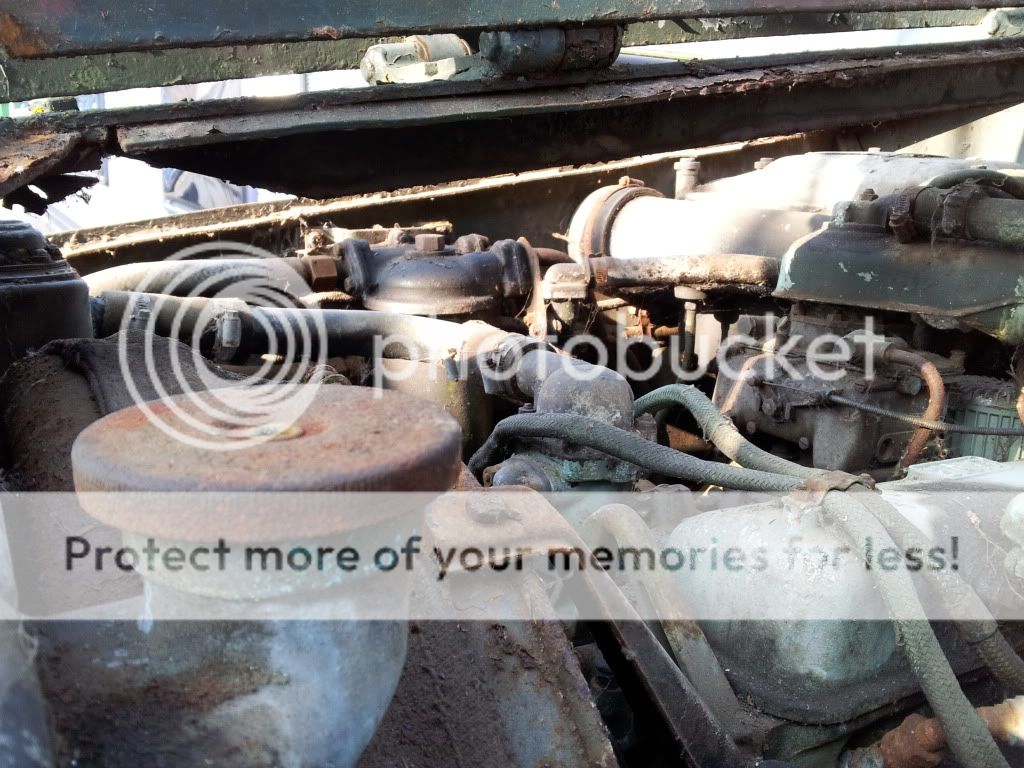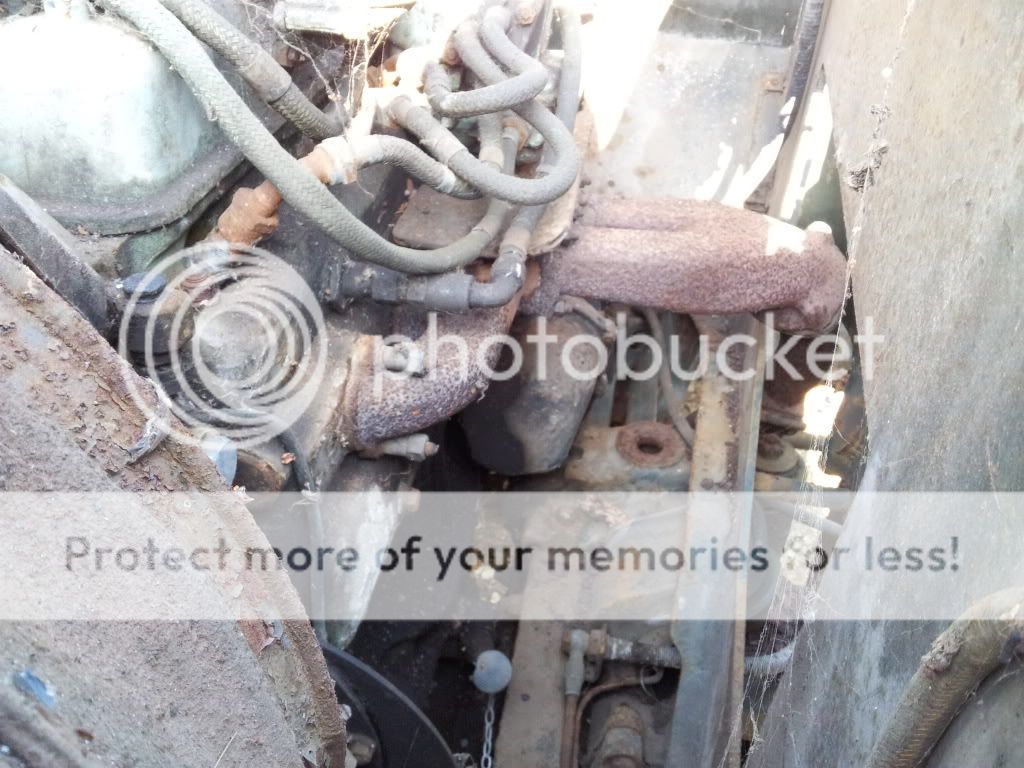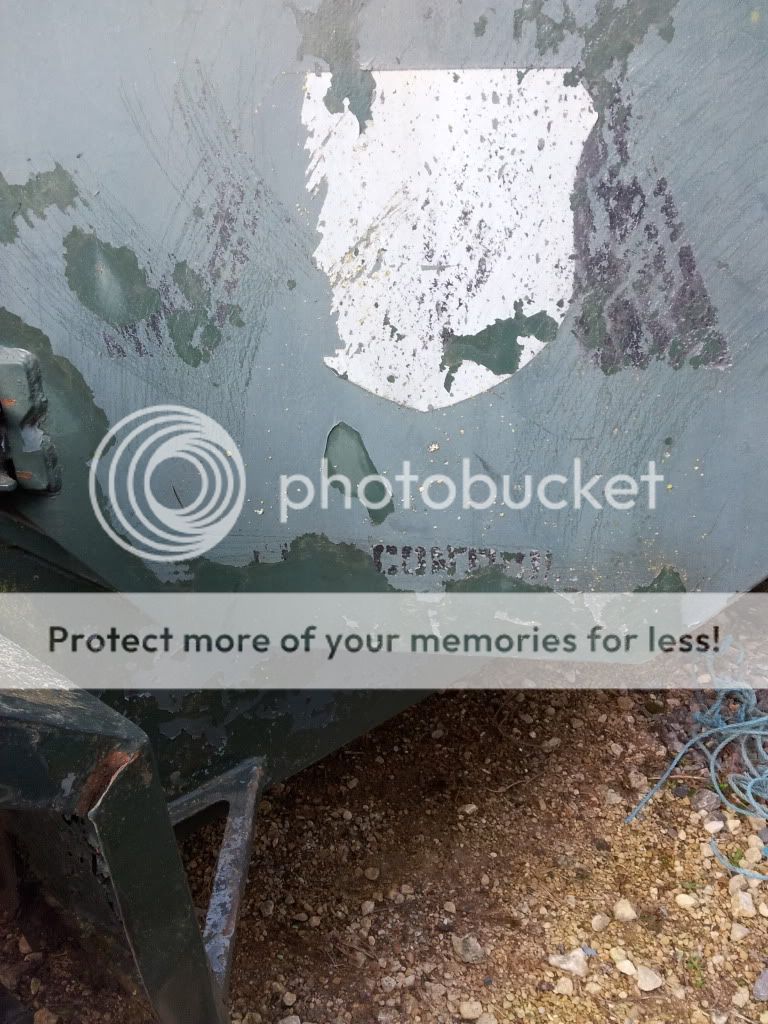
 |
|
#31
|
||||
|
||||
|
I have now managed to collect some salvaged and NOS panels for some of the lockers to fabricate replacements in due course thanks to Clive, Ashley and Alison.
Makes life a little easier for copying and the like. Regards
__________________
Wayne 1959 Royal Ordnance FV1611A Last edited by FV1611A; 23-02-12 at 00:58. |
|
#32
|
||||
|
||||
|
I also have 2 same pattern NOS inner wheel arch panels that will assist further together with a full length side locker cover / lid.....All Helps!
  
__________________
Wayne 1959 Royal Ordnance FV1611A |
|
#33
|
||||
|
||||
|
I have now move my Humber to a more ideal secure location where she can remain safe and workable....
Images of move and other matters attached.......There is a belief that this FV1611aas in a fil or TV series and hence the decals on the doors, which I have now discovered the words?????? CONTROL....In the UK someone suggested Doctor Who, which whilst totally amazing if cannot be collaborated right now!?         A small selection of Abstract Images......
__________________
Wayne 1959 Royal Ordnance FV1611A |
|
#34
|
||||
|
||||
|
I do not know the age of the tyres, but guess that the coating of tyrewall paint has preserved them further. The old tyre paint is now starting to flake, but as long as those sidewalls stay intact I will be happy as all 4 edges are Dunlop Trach Edge and Original fitment..........GOD Only knows if they are Original, Original........But after 1959 thats a big Guess
__________________
Wayne 1959 Royal Ordnance FV1611A Last edited by FV1611A; 02-03-12 at 23:30. |
|
#35
|
|||
|
|||
|
Nice to see the under bonnet pictures. Appears to be not a lot different from the original One Ton, apart from the revised air cleaner orientation, and the improved exhaust manifold.
Given the radical change in looks and role, I was illogically surprised by the typical Humber underneath. Is she a runner and a stopper? Or are you concentrating on the externals? I take it that the canvas gaiters are not an original fitment? Rich.
__________________
C60S Austin Champ x 2 Humber 1 Ton & Trailer |
|
#36
|
|||
|
|||
|
Hi
Another TV series that comes to mind that memory says they used one in was the Avengers. Memory also says that it might have been in one of the Tom Baker Dr. Who episodes. Now everyone has an excuse to watch old TV series, which may actually be better that what is being offered now. Cheers Phil
__________________
Phil Waterman `41 C60L Pattern 12 `42 C60S Radio Pattern 13 `45 HUP http://canadianmilitarypattern.com/ New e-mail Philip@canadianmilitarypattern.com |
|
#37
|
||||
|
||||
|
Quote:
Original Mk 1 tyres were marked "RF HS" (although the Army got it wrong & said it was HS RF) I think yours is marked "L" which is acceptable on a Mk 2 which may mean it is a later tyre. The other tyre type which I think must be a later type & was extensively used on Mk 2 was marked "RF EXTRA REINFORCED". Tyre types should not be mixed on the same axle. If there are REINFORCED tyres they should be fitted to the rear axle. BTW on a Mk 1 your fronts should be 25psi & rear 40psi. Kicking the tyres is no guide to pressure. I have driven on 0psi, although the steering was a bit peculiar 
__________________
Clive Elliott GW4MBS (Old) South Wales UK Last edited by fv1620; 09-03-12 at 13:00. Reason: Correcting an error from an official manual! |
|
#38
|
||||
|
||||
|
Clive I have no idea and will check as I am visiting her next week and doing some work and will take more pictures as well.
Torque reaction brackets and all that.....also I wish to see what lies in those floor lockers incase it is something of interest....Might as well whilst I am there. As explained on the HMVF forum I will be seeing if she wishes to turn over in a very controlled and sensitive way, so as to respect she has been stood for some time......... More pictures to follow in due course after visit next week and a sharing the knowledge visit to Clive........ No idea on TV or Film debute but was in Grey with Shields on Doors saying...'Something' CONTROL??? Also some kind of Tressle or Castlement Icon in Black behind shield???????????????? Makes me think more like a Bank Truck...Brinks Matt type thing, but Guessing Big Time!  Tyres and text visible to date    Rear Locker items stowed inside not known yet!?  Proper Tracta Joint Bellows in Rubber on Rear.....Leather Bogus on front and suspect Grease Packed     
__________________
Wayne 1959 Royal Ordnance FV1611A |
|
#39
|
||||
|
||||
|
At least with the rear locker you can put you hand up & have feel around.
But if you take the floor up you will need your Irwin extractors & most of the bolts will snap off unless you spend a lot of time with heat & release oil. But it will be a nice example of how Uncle Irwin can help in a difficult situation.
__________________
Clive Elliott GW4MBS (Old) South Wales UK |
|
#40
|
||||
|
||||
|
Clive on tyres does T24/C2 mean anything???
I can sort of make that text out but nothing else before visit.
__________________
Wayne 1959 Royal Ordnance FV1611A |
|
#41
|
||||
|
||||
|
Quote:
I will have blowtorch and penetrating oil so may be just lucky and work them lose and withdraw cleanly.......It's happened on Lightweight and that has been skinny dipping in Sea etc............. 
__________________
Wayne 1959 Royal Ordnance FV1611A |
|
#42
|
||||
|
||||
|
Nothing I'm familiar with. Maybe the inner walls will yield more detail where the sun don't shine.
__________________
Clive Elliott GW4MBS (Old) South Wales UK |
|
#43
|
||||
|
||||
|
You know I will crawl all over the tyre walls to see when I go on Wednesday......Yours the day after..........
So we can share my investigations first hand 
__________________
Wayne 1959 Royal Ordnance FV1611A |
|
#44
|
||||
|
||||
|
I have a question about GUNK......Engine Degreaser
If it is not rinsed off properly what does the residue do. Does it keep working to the point of damaging paints / coatings............... I must say the paintbrush cleaner works well and non-hazardoudsly. (well it was in my case).
__________________
Wayne 1959 Royal Ordnance FV1611A |
|
#45
|
|||
|
|||
|
Quote:
One thing that will happen if you don't wash it off then neutralize the surface is that when you do go to refinish it..even after sanding ..it will eat the new surface off..and it will start the minute you put the new surface on..Make sure you follow the manufacturers recommendations for cleaning the surface after use.
__________________
Alex Blair :remember :support :drunk: |
|
#46
|
|||
|
|||
|
Hi Wayne
Gunk and other degreasers containing or mixed with petroleum, must be carefully cleaned off after they have been use on painted surfaces, particularly paint containing flatteners such as military paints. The petroleum likes to hide in the porous surface of the paint or metal. Cast iron is a particular problem. That it leaves a oily residue may not be all bad though if you don't plan to paint right away. As suggested following the instructions would be a good idea, but maybe hard to do as the most recent jug of the traditional Gunk I purchase doesn't make any reference to cleaning surfaces for painting, nor could I find it on their web site. (Alex, I think you are right the instructions were there at one time.) I still use Gunk because it's still one of the most effective ways of dealing with grease and dirt mixed together, short of steam cleaning. Temperature and heat of the rinse water are the keys to the process below about 70F cleaning is slow to non existent. Rinsing with cold water seems to have a very limited effect may get the lumps of grease off but will leave oily residue. I use a biodegradable degreaser after washing off the Gunk solution. The hotter the water you use the better. Then before painting use Prepsol or another painting prep product. Once you have done all this to a bare piece of steel it will rust in a matter of days. Cheers and happy parts cleaning Phil
__________________
Phil Waterman `41 C60L Pattern 12 `42 C60S Radio Pattern 13 `45 HUP http://canadianmilitarypattern.com/ New e-mail Philip@canadianmilitarypattern.com |
|
#47
|
|||
|
|||
|
Hi Wayne
In my post about the Gunk, forgot to mention that I have been reading and following your project with interest. Keep up the good work and please keep us posted on the progress. As to Gunk- Just for laughs just went back on their web site and asked their tech person - Dr. Gunk - Where would I find information about cleaning surfaces for painting after using Gunk degreaser? It will be interesting to see what I get as a response. Cheers Phil
__________________
Phil Waterman `41 C60L Pattern 12 `42 C60S Radio Pattern 13 `45 HUP http://canadianmilitarypattern.com/ New e-mail Philip@canadianmilitarypattern.com |
|
#48
|
||||
|
||||
|
Quote:
As a bit of luck after some messaging on HMVF over here I did manage to aquire this wee item, which I am very excited about for the PIGGY.   After lots of rags and penetrating oil / WD40 she cleaned up quite nisely 
__________________
Wayne 1959 Royal Ordnance FV1611A |
|
#49
|
||||
|
||||
|
Whats the size of a wheel nut on a Humber Pig.......Also I assume a 6 ton bottle jack is okay under 1 wheel station to remove a wheel.
I know it should be a vehicle overall less than Jack capacity. Wonder what weight dispercement is on each corner??
__________________
Wayne 1959 Royal Ordnance FV1611A |
|
#50
|
|||
|
|||
|
1 1/8 AF socket will fit the Wheel nut. (Left hand thread on the passenger side of course)
Original jack for the cargo Humber was 4 ton, I imagine it would have been the same for the Pig as the loaded weight was similar. Rich.
__________________
C60S Austin Champ x 2 Humber 1 Ton & Trailer |
|
#51
|
||||
|
||||
|
Wayne it takes a bit of getting used to when you first jack up a Humber because of the independent suspension on each wheel station.
If you put the jack under the outer part of the suspension arm as you try to jack up the wheel, it stays put & that side of the rear axle goes down. If you jack up from the inner arm or diff guard, then as it goes up the wheel station keeps drooping down. What I do is place a couple of shortened railway sleepers on top of each other under the diff guard, then jack up from the outer part of the suspension arm. I prefer railways sleepers to a jack or an axle stand is that should there be some movement of the vehicle, it is not going to topple off the jack/axle stand. I always prefer a screw jack to a hydraulic one if I'm going underneath. Not just because you don't have to worry if the fluid screw is not fully in & it is going down slowly, but generally a decent screw jack will have a broader base than a bottle & less likely to topple. The Pig CES specifies Jack Screw, Hand lifting, Geared Triple lift, 4 ton, 7 in closed height, 18.5 in extended height, 5120-99-201-4907 I think a couple of years ago I posted a picture on one of the Humber threads on here.
__________________
Clive Elliott GW4MBS (Old) South Wales UK |
|
#52
|
||||
|
||||
|
Clive thank you. I did wonder how that suspension was going to work with a jack. At least a 6T Bottle Jack is sufficient rating for lifting a wheel!
I note the point on screw against hydraulic. 
__________________
Wayne 1959 Royal Ordnance FV1611A |
|
#53
|
||||
|
||||
|
Quote:

__________________
Wayne 1959 Royal Ordnance FV1611A |
|
#54
|
||||
|
||||
|
Quote:
The old girl cranked over the other day and spun freely. No fuel but allowed some lubrication to moisten the veins in her heart. The next day I had a good tutorial with Clive that made more sense as I am getting more aware of Humber facts instead of Land Rover. Few jobs next time may be gravity fed fuel delivery after the re-install of plugs blast cleaned by Clives friend 'Wally'. Nice piece of kit  . .I need to remove, inspect and replace as required fuel filter. Drop old fuel that is circa 10 years old  and flush tanks through. At least fuel is liquid and not varnish! The carb will be given a good health check and overall too. Probably refurbished before fitting. and flush tanks through. At least fuel is liquid and not varnish! The carb will be given a good health check and overall too. Probably refurbished before fitting. I also want to splash some rust protectant paint on a few patches to prevent any damage short term damage using Deproma! Good product
__________________
Wayne 1959 Royal Ordnance FV1611A |
|
#55
|
||||
|
||||
|
Quote:
In case anyone wonders who my friend Wally is, it is the brand name of an Italian compressed air sparking plug cleaner I use.
__________________
Clive Elliott GW4MBS (Old) South Wales UK |
|
#56
|
||||
|
||||
|
Just searched on MLU and NIL return. Where should I look...Forum or www.
Thanks Wayne
__________________
Wayne 1959 Royal Ordnance FV1611A |
|
#57
|
||||
|
||||
|
Wayne on here: http://www.hmvf.co.uk/pdf/PIGINAPOKE.pdf
__________________
Clive Elliott GW4MBS (Old) South Wales UK |
|
#58
|
||||
|
||||
|
Thank you. That is some articulation in that picture!

__________________
Wayne 1959 Royal Ordnance FV1611A |
|
#59
|
||||
|
||||
|
Saw Piggy on 28th March and noticed a few things, but did take two batteries and connected up. Got an ignition panel light and she turned over................
  Isolated the fuel as what was in one tank smelt like old gloss paint in a tin???? The fuel filter was fuel of old fuel, but no filter?  I had identified something in the rear storage locker under floor that transpired to be these items.        Lots of other images taken to follow;
__________________
Wayne 1959 Royal Ordnance FV1611A |
|
#60
|
||||
|
||||
|
Removing an awful lot of Gunge and it was evident that a historic custodian (Not PO) had painted some parts in the engine bay in DBG as I guess he didn't want to buy some SKy Blue?
  The internal relay and switches cover identified a couple of non standard alterations?  Internal controls and wiring     
__________________
Wayne 1959 Royal Ordnance FV1611A |
 |
| Thread Tools | |
| Display Modes | |
|
|